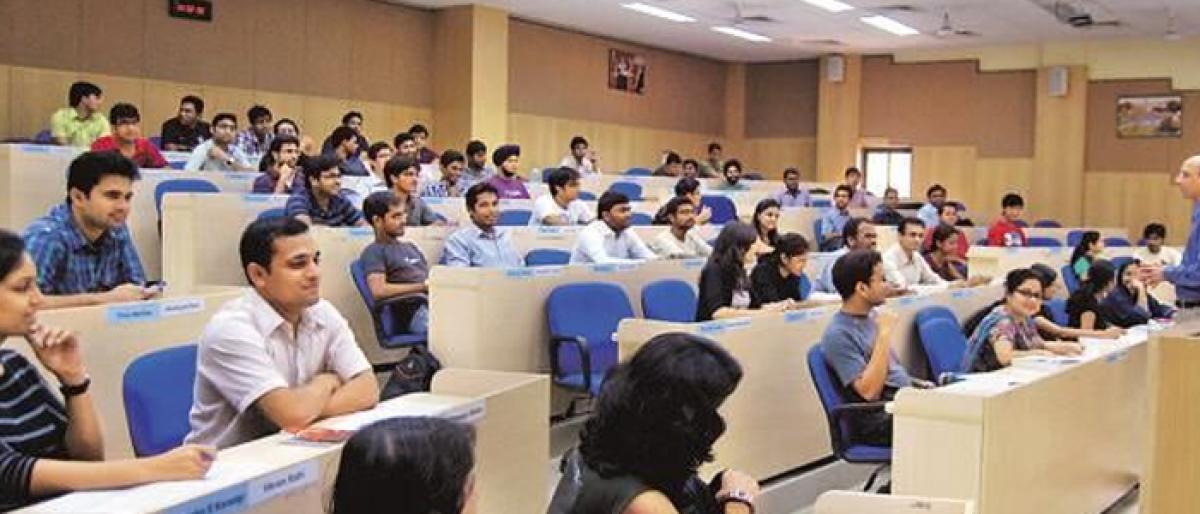Live
- Limited seats available for admission to Future-ready Career Programmes in NIIT University (NU)
- Myanmar floods displace 1,30,000; Magway region most affected
- Flashback: PM Modi's emotional encounter with wounded soldier during Kargil war
- All Party Committee Visit Pedda Vagu Bridge Construction in Ieeja Municipality
- Women’s Asia Cup: BCCI Secretary Jay Shah pens congratulatory message to ‘finals-bound’ Team India
- 3.16 acres of land originally purchased for Rs 1 in 1935: Siddaramaiah on MUDA land case
- SP T Srinivas Rao Plants Saplinngs
- Organic Farming Gains Traction in Nagar Doddi Village with Japanese University Visit
- Janhvi Kapoor Dazzles at "Ulajh" Event
- Nuclear power plants at Kudankulam delivers 100 billion kWh
Just In

India has an ambitious target of providing higher education to 40 million students by 2020 and to achieve the goal it should allow foreign universities to operate in the country – either through partnerships or letting them open their own campuses, says the Vice Chancellor of a top-rated Australian university.
New Delhi: India has an ambitious target of providing higher education to 40 million students by 2020 and to achieve the goal it should allow foreign universities to operate in the country – either through partnerships or letting them open their own campuses, says the Vice Chancellor of a top-rated Australian university.
Ian Jacobs, a surgeon-turned-academician heading the University of New South Wales (UNSW) in Sydney, is exploring how his institution can cater to the enormous demand and avail the massive opportunities in India's education sector, one of the world's largest. "The structure of higher education and regulations around it in India make that quite challenging. We are looking at how to do that and exploring innovations to do that," Jacobs told IANS during a trip to India.
"At the moment, it is not possible for an international university to open its own campus in India. But it may be possible for us to partner with an Indian university so that we can bring to India the depth of experience that we have in quality higher education at a very large scale. That is what we are exploring. It is quite a complicated environment to do that."
India has set an aggressive target of achieving 30 per cent gross enrolment ratio (GER) in higher education by 2020. GER is the total enrolment in higher education among the population in the age group of 18-23.
According to the Ministry of Human Resource Development, India's GER was 24.5 per cent in 2015-16, a quantum jump over the last decade when it was a mere 10 per cent in 2004-05. But the enrolment ratio is still low compared to China's 26 per cent and Brazil's 36 per cent.
To achieve the 2020 target and allow more and more young men and women access to higher education, Jacobs said, his university was ready "to contribute and create opportunities for new jobs and play a role in opening up the young people's eyes to the opportunities for their life.
"We provide higher education of quality on a large scale. And that is something India very badly needs. The ambition in India is to educate many millions of young people to degree level." UNSW offers courses in art and design, arts and social sciences, environment, business, engineering, law, medicine and science and has a range of scholarships for international students.
India also needed foreign university collaborations because the scale of operations of high-quality educational institutions in the country would not be able to deliver on the government's target and the country's need. But the real exciting thing would be to be involved in India – providing higher education to Indians in India.
UNSW's Pro Vice Chancellor Laurie Pearcey said the Indian government's Institutions of Eminence or the 10+10 initiative – to give 10 public and 10 private institutions unprecedented administrative and financial autonomy – has thrown up possibilities for partnering with foreign universities.
The proposed Foreign Educational Institutions (Regulation of Entry and Operations) Bill that seeks to permit foreign players into the higher education system could make things better for the country. Regulation is a good thing but at the end of the day the government is interested in quality and at the same time that does come at the expense of collaboration.
Former Indian diplomat Amit Dasgupta, UNSW's Country Head in India, said besides the 10+10 initiative India needed 400 new universities and 40,000 new colleges to achieve a 30 per cent GER by 2020.
"If you need to upgrade, if you need to have quality faculty, one has to ask what is the purpose of higher education. "And that purpose will determine the kind of collaboration. If the purpose is only employability, that is one approach. If the purpose is innovation and research, that is another approach. But I think all of this gets combined somewhere and I think this upgrading is going to only happen through collaboration with world-class foreign universities." (IANS)

© 2024 Hyderabad Media House Limited/The Hans India. All rights reserved. Powered by hocalwire.com







